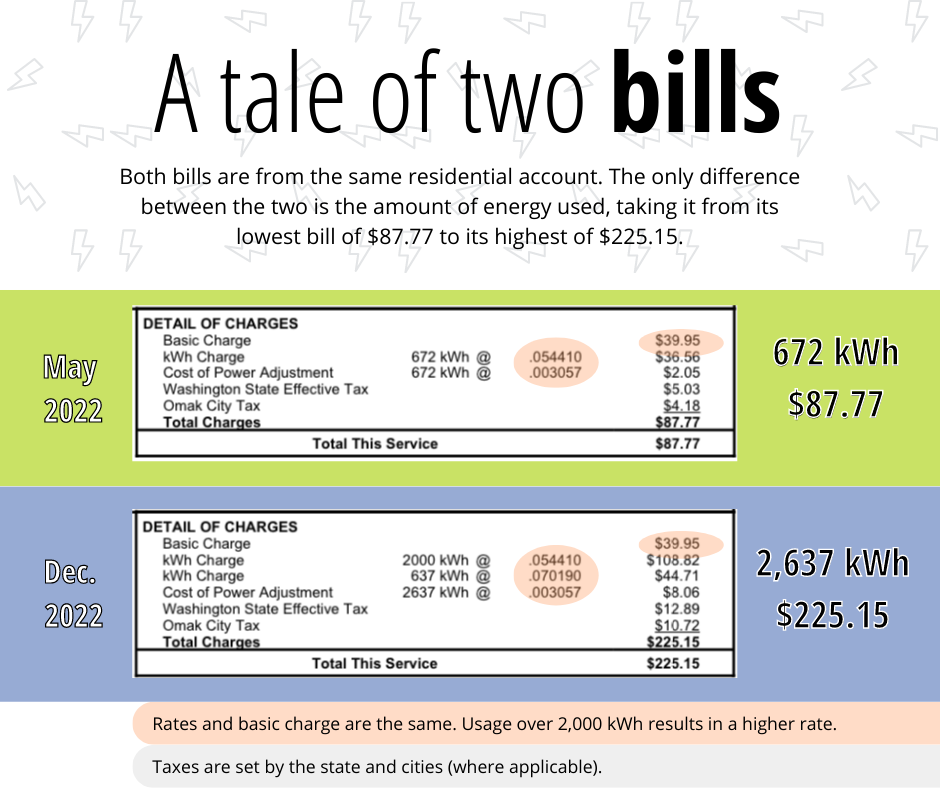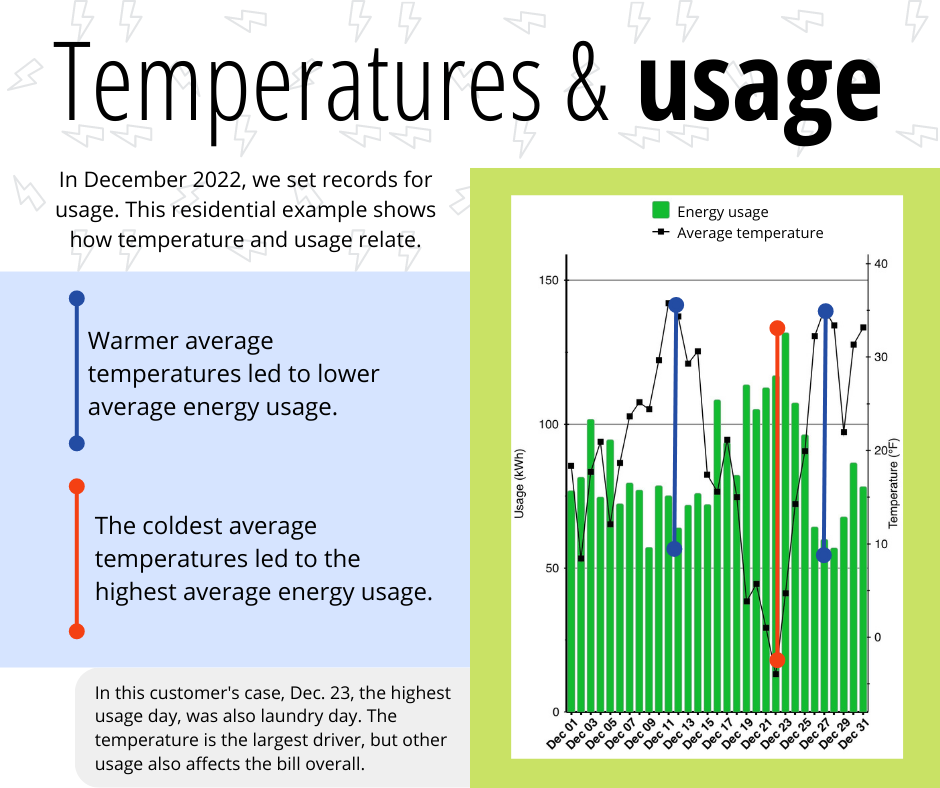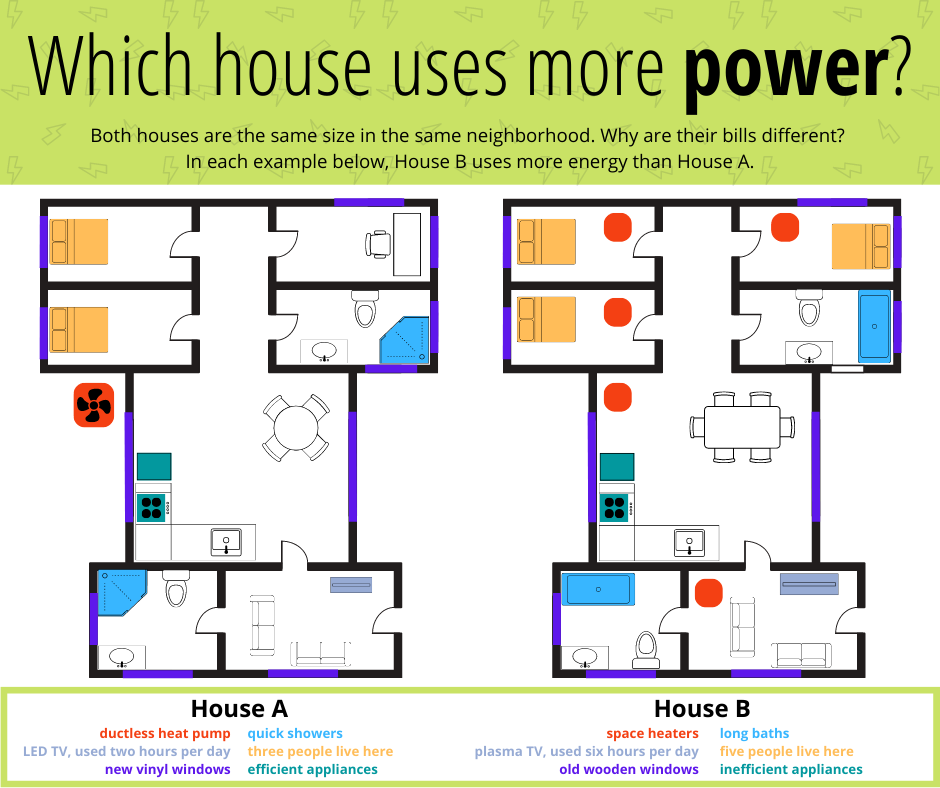Every winter, our region experiences its highest average bills of the year. December 2022 was particularly rough, with record-breaking cold resulting in record-breaking power usage, and, therefore, some of the highest bills many folks have ever had. We get a lot of common questions about high bills, particularly in winter, so we wanted to answer those frequently asked questions:
- Q: Did my rates go up in December?
A: No, but usage did.
Your Okanogan PUD bill is made up of several parts:
- The basic charge: A flat fee every month for every meter.
- Taxes: Determined by the state and in some cases by cities.
- Kilowatt-hour (kWh) charge & Cost of Power Adjustment: These only change once per year, usually April 1, if at all. These are charged based on how much energy a customer uses.
It’s the kWh usage that changes bills from month to month. Months like May have low usage with mild temperatures, and months like December tend to have the highest usage and highest bills. Just like anything else, the more we use, the more we pay.
In our current rate structure, residential energy charges have two tiers of rates: usage under 2,000 kWh per month is a lower rate than usage over 2,000 kWh per month. So, the higher usage also kicks in the higher rate. This tiered system, however, is being phased out in the next couple of years after which the rate will be the same no matter the amount of usage.

- Q: I didn't touch my thermostat, so why is my bill higher?
A: Your system works harder and takes longer to heat your home in extreme cold.
Let's say your thermostat is set to 68 degrees (which is our recommendation for winter). When it's 48 degrees out, your system works as long as it takes to raise the inside temperature by 20 degrees to battle the chill outside. Whether you have a space heater, ductless heat pump, electric furnace, etc., that system will turn off when the thermostat shows 68 degrees has been reached. So, depending on the insulation, size, and overall condition of the home, your heater might only need to be "on" and using energy a few hours total per day.
Now, let's say it's ZERO degrees outside. In December, that happened a lot (or negative temperatures). Now that same heating system has to raise the temperature by 68 degrees to get to that place where the thermostat tells your system it can take a break. With such a greater temperature change, the heating system stays on longer, if it turns off at all - you might go from your heater working 8 hours per day to 24 hours per day, which triples that portion of your bill. We charge in kilowatt-hours, or how much energy is used for a particular amount of time.
With a standard 1,500-watt space heater, it's about 8 cents per hour of usage, which doesn't sound like a lot. But if you run that for 12 hours per day for a 30-day billing period, it's now $30 on a bill. Run that same space heater 24 hours per day and it's $60.
In the case of heat pumps, some can't keep up with extreme low temps and will turn on emergency heat (sometimes also called auxiliary or strip heat), which requires an additional amount of energy. If a heating system is poorly maintained, damaged, dirty, or having other issues, it will work longer and might cause additional energy usage as well.

- Q: Why are bills so much higher in winter in general?
A: Shorter days, colder water, warm goodies, more movies.
Aside from the reasons mentioned in the question above, the shorter, darker days of winter have two other consequences:
- We tend to turn on more lights for longer periods of time, hence additional energy usage.
- We don't get as much warmth from the sun, so the temperatures are colder and we can't use as much sunlight to naturally heat our homes - we rely heavily on our heating systems (see question 2).
The colder days also mean colder water coming into our homes, so water heaters work harder and longer, too. Hot water heaters are the second largest consumers of energy in a home after heating/cooling systems. Water heaters are typically turned on and potentially working 24 hours per day.
And, let's face it, there's nothing like a nice hot shower or bath on a cold day. We all are more likely to use more hot water in the winter than summer. We might even drink more hot beverages and cook warmer meals, resulting in additional use of appliances, too.
Without as many outdoor activities in the winter, we are more likely to use electronics more frequently for entertainment, adding to energy usage as well.
- Q: My house is the same size as my neighbor's - why is their bill half as high as mine?
A: Probably a hundred reasons.
Household comparisons for bills rarely work because no two households are alike, even if the structures themselves are the same size.
Let's say there are two 1,400 square-foot homes in the same neighborhood. Obviously, they experience the same weather and heat the same amount of space. That's where the similarities might end. If you're going to compare two places, here are some questions to ask:
- How many people live there full-time? Are there frequent guests or parties? The more people, the more energy is used for hot water, appliances, electronics, etc.
- What is the condition of the home? Is there good insulation, efficient windows and doors, LED lights, and efficient heating and cooling systems?
- What are the habits of the people in the home? Do they leave lights on and crank up the thermostat? Do they close the fridge door and exterior doors and windows? How often do they use electronics or appliances? How frequently do they do laundry or take showers?
We could go on - the number of variables driving a household's bills feels a bit endless. We share a lot of information on our website and Facebook about easy-to-do energy efficiency tips and tricks.
Want to know how much energy you use each day? Check out your SmartHub account, free for PUD customers. If you see a day of usage that seems way higher or lower than usual, ask yourself what was different about that day: Was it much colder so your heater was on longer? Did you do laundry all day and see the increased energy usage for that? Were you gone on vacation and hardly saw any usage?
If you can't figure out what is causing high energy usage in your home, we can help with more detailed "energy audits" that you can do yourself or we might be able to take a look and make suggestions.

- Q: Is there any assistance available if I can't pay my bill?
A: Absolutely!
We work with several partners in our communities to help our customers who struggle to pay their bills.
- Payment arrangements - whatever the reason for struggling to pay, we can set up a payment plan to work with customer budgets.
- Okanogan County Community Action Council - anyone qualifying for low-income assistance can see what programs are available to help cover part or all of their bill.
- Project Help - funded by PUD customer donations, this is administered by Community Action as well.
- Colville Confederated Tribes - the office administers funds for Colville Tribal members, such as senior heating and other programs.
And there's more! Give us a call, or call Community Action or the Colville Tribes to see what assistance might be available.